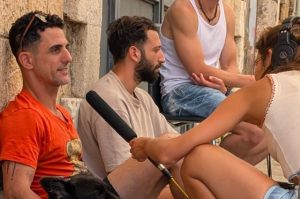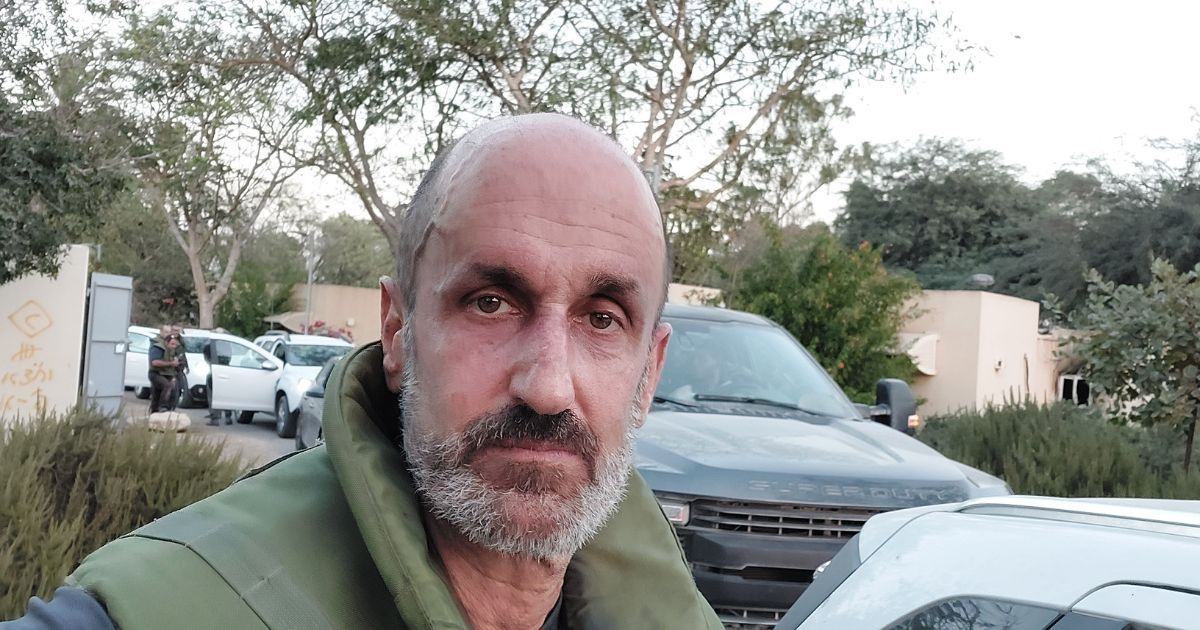The IDF turned to archeologists to do heartbreaking work.
Hai Ashkenazi: In some of the houses, there were still people in it when they burned it. And if there was someone there, the body also get cremated. So only few remains are staying and this is why they brought us there. You know, because we know how to deal with this stuff.
Mishy Harman (narration): Hey listeners, it’s Mishy. So as you know, during these incredibly difficult days, we’re trying to bring you voices we’re hearing among and around us. These aren’t stories, they’re just quick conversations, or postcards really, that try to capture slivers of life right now. 53 year old Hai Ashkenazi from Tel Aviv is an archaeologist, but probably never imagined he’d find himself excavating a 21st century kibbutz. Yet in the insane reality that has become our life since October 7th archaeologists too are part of the war effort. Our producers, Alexandra Moller and Zev Levi sat down with Hai, and heard how the term destruction layer has accrued a contemporary and chilling meaning.
Before we begin, a quick warning, while most of our Wartime Diaries contain references that might not be suitable for all listeners, this one deals directly with death. So please take that into account. Okay, here’s Hai.
Hai Ashkenazi: So my name is Hai Ashkenazi. I have a PhD in archaeology. I dealt with the Bronze Age, especially the early Bronze Age, like around 3000 BCE. Now I, in the last almost two years, I work in the Israeli Antiquities Authority. I’m the geoinformatics Manager—which deals with documentation of the data and archeological sites and the finds we find in it.
So on October 7th, I woke up at 6:30 from the siren. In Tel Aviv you have a minute and a half to get to the shelter. We live in an old building which has a very old shelter from the 60s in the basement of the building. It has windows, which is a bit strange for a shelter. But somehow we managed to get there in minute and a half…until we could hear the Iron Dome going off. And we just sat there. And there were, I think, there were a few sirens. And then we went up. And then you read in the news and you see something is happening around Gaza. And I told my partner: “That never happened; this is something different.” And then you hear more and more. And every hour there are more victims and more people killed. And you understand there’s not a lot of army there and people are getting killed. And so it was like crazy day. Like a storm, a storm of death and sorrow.
Actually the first thing I wanted to do is to take the car and to help evacuate people. And my partner was so terrified, so I didn’t do it. So she’s German. And now, now like, she was so terrified. So that we…there was like evacuation flights to Germany. So, we managed to find a spot on one of the flights, which was not easy. And she’s there. And I am so much calmer that she’s not here because she was afraid to walk in the street. She wanted me to come with her and I told her: “I know it’s not logical, but I can’t. I just can’t.” I didn’t know how can I help, but they I have to stay here. I don’t know if I can explain that. I think in the beginning what I felt is anger, anger and helplessness. And since then, I think my anger is changing to sorrow—like I’m so sad: like it’s the saddest month of my life.
I was in tanks when I was in the army, so I wanted to do something on the front and then what happened is—there was an officer in the army who was responsible to find missing people. Nobody knows exactly what’s the number. It might even be that some of the people who said that were kidnapped maybe are missing. So there’s a unit in the army that is responsible for that, and they don’t have the abilities to find people that are in the burnt houses because they either are looking for bodies, and they need someone else that knows how to deal with destruction…destruction layers. And archeologists actually love destruction layers because it’s like freezing time of one period and you find a lot of stuff in it. And then they gathered a team and they asked me.I was pretty shocked from the idea. I said: “Give me a day to think about it.” And after I said: “Yes, I’m in.”
So my first day was…like you, you drive in a convoy with the army to the kibbutz. We went to Nir Oz. This is a kibbutz that was raided, and the army didn’t get to it: like about a quarter of the population was either murdered or kidnapped. And actually when you get to do it looks a bit kind of pastoral. So the birds are singing and the grass is still green. Only when you look a bit better, you can see something is wrong. You hear explosion in the background, either from our artillery or from the Hamas missiles. And if in Tel Aviv you have a minute and a half to run to shelter, there you have 15 seconds. So the only thing you can do is just lie on the ground and hope it doesn’t hit you.
The hardest thing for me in the beginning was the smell—because it’s smell of burning woods, but also burning plastics. So the kibbutz is totally deserted and all the houses are open and I just went into houses. And as archeologists you usually are trained to look at material culture and and understand what happened there. So you go to a house and you see bullet holes…next to the lock. And then you go inside and you see bullet holes on the door of the shelter, and the door is open, and you go inside and you see a pool of bloods. And just every house you go there something happened in it…every house. Usually what we go, we go to houses that we know someone is missing from this house, and we just dig very slowly. We sift through the ashes…like we have sifters and we sift through the ashes and we try to find remains of the people there. And until now they found about 10 missing people.
Zev Levi: The bodies.
Hai Ashkenazi: Well you can’t even say bodies because it’s really like remains of bones; sometimes it’s just teeth; sometimes it’s other… jewelry and stuff like that—you know they wore before the attack. Generally in archeological excavation we are really happy to find bones because usually you find the person and you find the jewelery on the person…and the person, and you find what the person held before dying. But I really think that what we’re doing now it’s more police work and less archaeology.
So this is how it looks like: so the walls are black and everything is black and gray. And you just sift through the ashes.
Zev Levi: Did you take these pictures as a part of your work?
Hai Ashkenazi: No, for myself. I’m like amateur photographer. So every, every house is a private house, every house you spray on it that we’ve been here, and we checked it
Zev Levi: This is the Israeli army spray painting on the side of an Israeli house?
Hai Ashkenazi: Yeah. We’ve been here, we checked that there are no bombs in it, and then we checked here…the Antiquities Authority, we’ve been here, we checked there’s no missing people here.
Zev Levi: I see the dates as well.
Hai Ashkenazi Yeah. And also the dates. And in the beginning when I needed to spray it I couldn’t: It’s someone’s house; I don’t want to spray on the house. And then you understand nobody’s going to live there anymore.
In one of the houses that later we understood that the mother was murdered, two kids probably kidnapped, and the father is missing—he’s what we’re looking. So we just found in one of the rooms, we found like a lot of pottery that the kids probably made in kindergarten. So we just kept all of them for if someone will come back from the family at least they have some souvenir.
It’s so strange because usually when I dig I find things which are kind of strange to me, and foreign to me, and this is things I can find in my house as well. I really think…it’s what I saw it’s worse than what I read in the news, even in the small things. So in one of the houses it was like kind of a corridor and there was a small sofa and all the small stuff: everything was black. It was hard to understand what it is. There was like a pile of things on the sofa. And then I understood it’s like very neatly folded clothing. So you can really see the clothing was there and it was all black of soot and ashes, and it was just there.
I think in the second day what I understood is that they don’t want to know details. I just need to go there do my technical job and that’s it. Because in one of the houses we’ve been…someone started to explain what happened to the family, and who are we looking for. And at one point, I said: “No, I don’t want to know.” You have to be like professional. It’s like I guess like doctors that go to operate someone, they prefer not to know who they’re operating.
I’m not a pacifist, but I am not pro-war. And I think really Israel has no other option but to hit back. And I know that hitting back is we kill a lot of civilians and it’s also in my name and it’s really hard for me, and I’m really sad about it. But I don’t think there’s another way right now. And it’s really sad to say that. And I hope after the war, we can do something to prevent the next ones—which is not connected to violence. I think you have…everyone has to choose to be optimistic because we don’t have room for pessimism. So we have to be optimistic in the hope that all this bloodshed eventually will bring something better.
Zev Levi: Hai, thank you so much for coming in and thank you for your work.
Hai Ashkenazi: Thank you. You’re welcome




